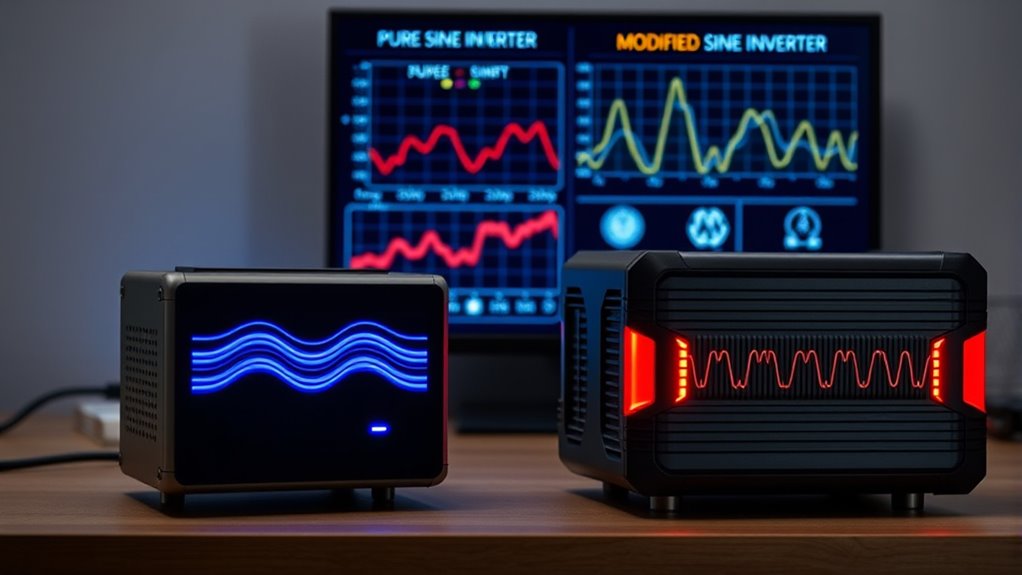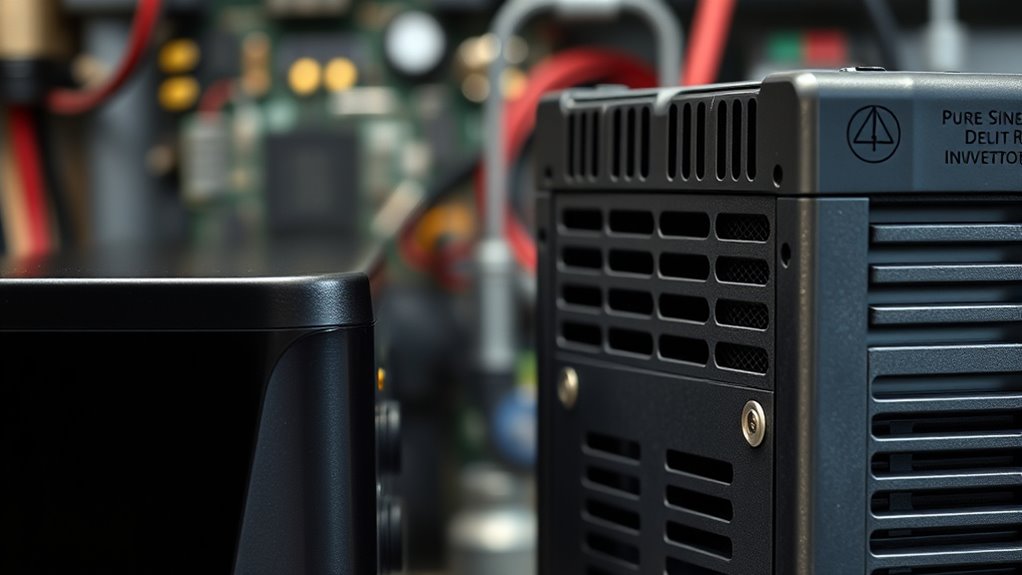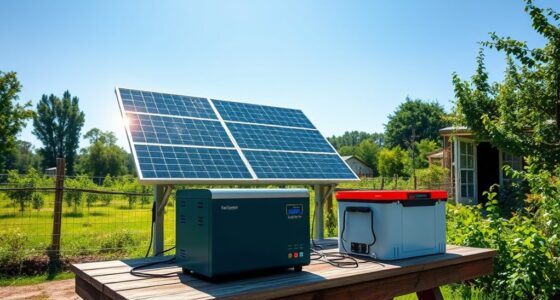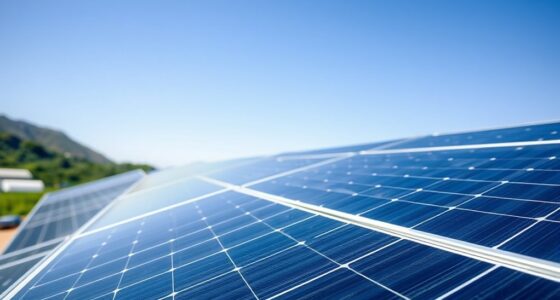Choosing the right inverter impacts your system’s efficiency and device safety. Pure sine wave inverters produce smooth, grid-like power ideal for sensitive electronics and offer higher efficiency, reducing energy waste. Modified sine wave inverters are cheaper but can cause humming or damage in some appliances, lowering overall efficiency. Beyond these, hybrid inverters combine features for better energy management. Understanding these differences helps you optimize your setup—stick around to uncover more about selecting the best inverter for your needs.
Key Takeaways
- Pure sine wave inverters produce smooth, grid-like power, offering higher efficiency and better compatibility with sensitive electronics.
- Modified sine wave inverters generate a rougher waveform, are cheaper, but may cause reduced efficiency and device malfunctions.
- Advanced inverter types, such as hybrid inverters, optimize energy flow and improve overall system efficiency by integrating multiple functionalities.
- Proper inverter sizing, whether pure or modified sine, ensures maximum efficiency, prevents overloads, and extends equipment lifespan.
- The choice between inverter types depends on application sensitivity, budget, and desired system efficiency.

Have you ever wondered how different inverter types impact the efficiency of your solar or power systems? The answer lies in understanding how inverter selection influences overall performance, especially when it comes to battery capacity and inverter sizing. Choosing the right inverter isn’t just about matching it to your system’s voltage; it’s about optimizing the entire setup for maximum efficiency. For example, if your system’s battery capacity is large, you’ll need an inverter that can handle the power demands without losing energy. Proper inverter sizing ensures you don’t overload or underperform, which can lead to wasted energy or equipment damage. Smaller inverters might be cost-effective initially but could struggle with larger loads, reducing efficiency and lifespan. Conversely, oversized inverters can be more expensive and less efficient for your specific needs.
When it comes to inverter types, the two most common are pure sine wave and modified sine wave inverters. Pure sine wave inverters produce a smooth, consistent AC power output, closely resembling the electricity from the grid. This type is highly efficient, especially with sensitive electronics, and minimizes power loss during conversion. If your system includes appliances like computers, medical equipment, or audio-visual devices, a pure sine wave inverter is essential to prevent damage and maintain efficiency. On the other hand, modified sine wave inverters generate a rougher, stepped waveform. They are generally less expensive but can cause issues with some appliances, such as humming sounds, overheating, or reduced lifespan. Their efficiency is lower, particularly with devices requiring clean power, leading to increased energy waste.
Beyond these two, there are advanced inverter types like hybrid inverters, which combine features of both grid-tie and off-grid systems. These are designed to optimize efficiency by intelligently managing power flow and battery charging. Choosing the right inverter type affects your system’s overall efficiency because it influences how effectively energy is converted and utilized. Proper inverter sizing, considering your battery capacity and power needs, ensures that your system operates at peak performance without unnecessary energy losses. Oversized inverters may lead to wasted capacity, while undersized ones can cause frequent shutdowns or damage. Additionally, understanding system efficiency factors can help in selecting the most suitable inverter for your setup.
Frequently Asked Questions
How Do Inverter Efficiencies Impact Overall Energy Consumption?
Inverter efficiencies directly impact your overall energy consumption by reducing power loss during conversion. Higher efficiency means less energy wasted as heat, so you get more usable power from your system. When you choose inverters with better efficiency metrics, you’ll notice lower energy bills and improved performance. Conversely, less efficient inverters cause more power loss, making your system less effective and increasing your energy costs over time.
Are There Safety Concerns With Different Inverter Types?
You should be aware that different inverter types can pose safety hazards, especially regarding electrical shocks. Pure sine inverters generally have safer, more stable output, reducing shock risks, while modified sine inverters might cause unexpected electrical issues. Always follow safety guidelines, verify proper grounding, and handle inverters carefully to prevent electrical shocks and other hazards. Proper maintenance and cautious operation help keep you safe regardless of inverter type.
What Maintenance Is Required for Various Inverter Models?
You need to regularly check your inverter’s connections and clean any dust or debris to guarantee proper cooling. For different models, follow manufacturer guidelines on cooling requirements to prevent overheating. Also, monitor your battery lifespan, as an aging battery can reduce inverter performance. Keep an eye on ventilation and consider replacing batteries when their capacity diminishes, maintaining efficiency and safety over time.
Can Inverters Be Used for Both Residential and Industrial Applications?
Yes, you can use inverters for both residential and industrial applications. To do so effectively, guarantee grid compatibility and select the right inverter sizing for your needs. For residential use, smaller inverters work well, while industrial settings require larger, more robust models. Proper sizing prevents overloads, and checking grid compatibility ensures seamless integration with your local power system, maximizing efficiency and safety across both applications.
How Do Inverter Warranties Compare Across Brands and Types?
Think of inverter warranties as a handshake; some brands offer a firm grip, others a gentle squeeze. Generally, reputable brands provide longer, extensive warranty coverage, reflecting confidence in their quality. You’ll find that higher-end models often come with more generous warranties, while budget options might have shorter coverage periods. Comparing warranties across brands helps you gauge reliability, so choose an inverter backed by a solid reputation and warranty coverage that stands the test of time.
Conclusion
Choosing between pure sine and modified sine inverters isn’t just about efficiency; it’s about understanding your needs. While pure sine inverters offer smooth, reliable power like a calm lake, modified sine inverters are more like choppy waters—cost-effective but potentially rougher on your devices. Both serve a purpose, but knowing when to prioritize quality over savings makes all the difference. Ultimately, your choice reflects not just your power needs, but your approach to reliability and value.









